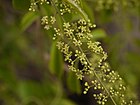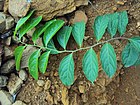Note: This is a project under development. The articles on this wiki are just being initiated and broadly incomplete. You can Help creating new pages.
Celastrus paniculatus - Jyotishmati
Jyotishmati is a deciduous, climbing shrub producing stems up to 10 metres long and 25cm in diameter. The stems twine into the surrounding vegetation, helping to support themselves by means of hooked prickles. The plant is harvested from the wild for local use as a medicine and source of oil. The oil has gained a high reputation medicinally and is exported for use in a range of medications.
Contents
- 1 Uses
- 2 Parts Used
- 3 Chemical Composition
- 4 Common names
- 5 Properties
- 6 Habit
- 7 Identification
- 8 List of Ayurvedic medicine in which the herb is used
- 9 Where to get the saplings
- 10 Mode of Propagation
- 11 How to plant/cultivate
- 12 Commonly seen growing in areas
- 13 Photo Gallery
- 14 References
- 15 External Links
Uses
Memory loss, Rheumatic arthritis, Insomnia, Opium poisoning, Impotence [1]
Parts Used
Chemical Composition
Common names
| Language | Common name |
|---|---|
| Kannada | bhavanga beeja, gangunde kaayi, gangunga hambu, maala kanguni |
| Hindi | malakanguni, malkauni |
| Malayalam | ceruppunna, palulavam, paluzhavam |
| Tamil | carasvati, acuvalakkal, malgangunicinnavaluluvai |
| Telugu | baavanji, gandumida, |
| Marathi | NA |
| Gujarathi | NA |
| Punjabi | NA |
| Kashmiri | NA |
| Sanskrit | agnibhasa, jyotishlata, jyotishmati, supingala, swarna lata |
| English |
Properties
Reference: Dravya - Substance, Rasa - Taste, Guna - Qualities, Veerya - Potency, Vipaka - Post-digesion effect, Karma - Pharmacological activity, Prabhava - Therepeutics.
Dravya
Rasa
Tikta (Bitter), Katu (Pungent)
Guna
Teekshna (Strong), Snigdha (Oily)
Veerya
Ushna (Hot)
Vipaka
Katu (Pungent)
Karma
Vata, Kapha
Prabhava
Habit
Identification
Leaf
{{Leaf|Simple|Alternate| broadly ovate, apex abruptly acuminate, base ronded or acute, crenulate; petiole 6 mm long. }[3]
Flower
| Type | Size | Color and composition | Stamen | More information |
|---|---|---|---|---|
| Bisexual | terminal and axillary panicles | Yellowish white | 5 | Panicle to 15 x 8 cm, terminal, axillary, oblong; pedicel 6 mm long; flowers many, 6 mm across. Sepals 5, small, imbricate, ciliate. Petals 2.5 x 2 mm, white, ovate, obtuse. Stamens 5, erect, anthers sagitate at base. Ovary 3-celled, cell 2-ovuled, stigma 3, recurved. |
Fruit
| Type | Size | Mass | Appearance | Seeds | More information |
|---|---|---|---|---|---|
| A capsule | Capsule to 1 cm across, loculicidal, yellow | seeds 3, aril reddish. | {{{5}}} | {{{6}}} |
Other features
List of Ayurvedic medicine in which the herb is used
Where to get the saplings
Mode of Propagation
How to plant/cultivate
Season to grow
Soil type
Propagation
Commonly seen growing in areas
Photo Gallery
References
External Links
- Ayurvedic Herbs known to be helpful to treat Memory loss
- Ayurvedic Herbs known to be helpful to treat Rheumatic arthritis
- Ayurvedic Herbs known to be helpful to treat Insomnia
- Ayurvedic Herbs known to be helpful to treat Opium poisoning
- Ayurvedic Herbs known to be helpful to treat Impotence
- Herbs with Seed used in medicine
- Herbs with Leaves used in medicine
- Herbs with common name in Kannada
- Herbs with common name in Hindi
- Herbs with common name in Malayalam
- Herbs with common name in Tamil
- Herbs with common name in Telugu
- Herbs with common name in Sanskrit
- Habit - Climber
- Index of Plants which can be propagated by Seeds
- Index of Plants which can be propagated by Cuttings
- Herbs that are commonly seen in the region of Tropical area
- Herbs
- Climber





